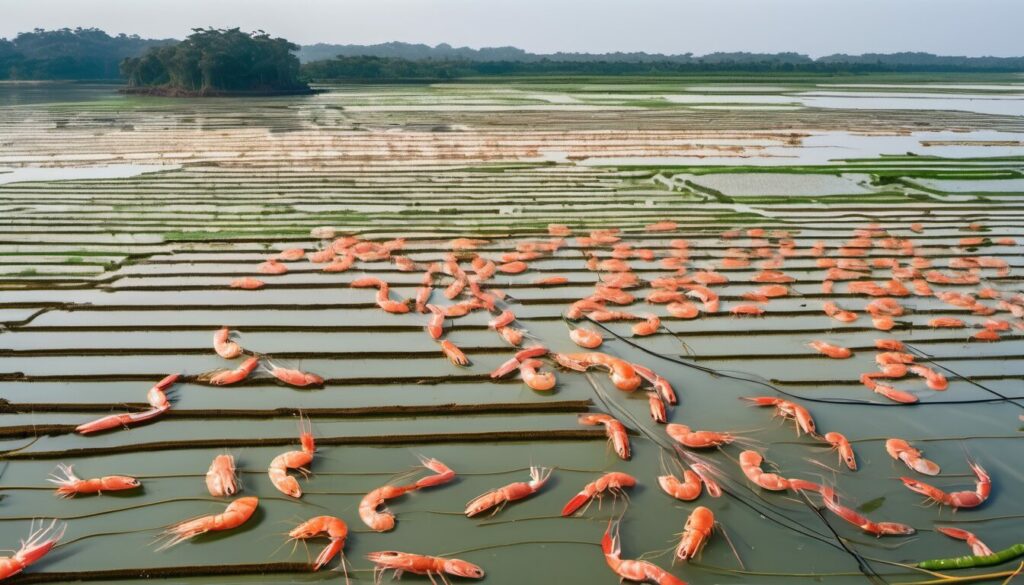Shrimp farming, a big part of the fish farming industry, is changing a lot because of new technologies and ways of doing things. These changes are making it better at producing shrimp, saving resources, and taking care of the environment. In this article, we’ll talk about the new and cool ideas that are changing shrimp farming and making it even better for the future.
Recirculating Aquaculture Systems (RAS)
In shrimp farming, new ideas are important to keep up with the growing need for seafood while taking care of the environment. One big change is the use of recirculating aquaculture systems (RAS), which are making a big difference in how shrimp are grown.
Understanding Recirculating Aquaculture Systems (RAS)
RAS is a new way of farming shrimp that’s different from the traditional method. Instead of using open ponds, RAS keeps water inside a closed system. This system helps control the water quality, temperature, and oxygen levels, which are important for shrimp to grow well. RAS also uses special filters and treatments to keep the water clean and free from harmful things that could hurt the shrimp.
Key Components of RAS
In RAS, water is constantly circulated through a series of filters to remove waste and harmful things. These filters include mechanical, biological, and chemical filters. Some RAS also use treatments like UV sterilization and ozonation to make the water even cleaner and safer for the shrimp.
Benefits of RAS
RAS has many benefits for shrimp farmers. It uses less water and produces less waste compared to traditional methods. This means it’s better for the environment. Also, because the water is clean and controlled, there’s less chance for diseases to spread among the shrimp. This helps the shrimp grow faster and healthier, which is good for the farmers’ business.
Environmental Sustainability
RAS helps protect the environment by using less water and reducing pollution. By keeping the water clean and controlled, RAS also helps preserve natural habitats and ecosystems. This makes RAS a more sustainable way of farming shrimp compared to traditional methods.
Economic Viability
RAS isn’t just good for the environment; it’s also good for business. Farmers can control the conditions in RAS to make sure the shrimp grow well and stay healthy. This means they can produce more shrimp of better quality, which can make their business more profitable. RAS can be used by both small-scale and large commercial shrimp farms.
Challenges and Considerations
While RAS has many benefits, there are also some challenges. Setting up and running RAS can be expensive, especially for small-scale farmers. It also requires special knowledge and skills to manage the system effectively. Also, RAS uses energy, so farmers need to find ways to make sure it’s used efficiently.
Future Outlook
Despite the challenges, RAS is expected to become more popular in the future. As more people want seafood that’s produced sustainably, RAS offers a solution. By continuing to research and improve RAS technology, farmers can make shrimp farming even more efficient and sustainable. This will help ensure a brighter future for the shrimp farming industry.
Selective Breeding and Genetic Improvement
In shrimp farming, new methods like selective breeding and genetic improvement are making big changes, helping the industry grow more shrimp while taking care of the environment.
Selective Breeding: Making Shrimp Better
Selective breeding is a way to make shrimp better by choosing which ones to breed based on their traits. Shrimp farmers pick shrimp that grow fast, resist diseases, and survive well. By mating these shrimp, they make baby shrimp with even better traits. This helps shrimp farms produce more shrimp that grow faster and are healthier.
Advanced Genetic Techniques: Making Breeding Faster
New genetic techniques help shrimp farmers breed shrimp faster and more accurately. Methods like marker-assisted selection (MAS) and genomic selection help farmers pick the right shrimp for breeding. By looking at the shrimp’s genes, farmers can choose which ones will make the best babies, making the breeding process quicker and more effective.
Benefits of Genetic Improvement Programs
Improving shrimp genes has many benefits for shrimp farms. Shrimp with better genes grow faster, resist diseases, and survive better, leading to more shrimp and more profit. Also, these shrimp are better suited to the shrimp farm environment, so fewer of them die. Using better shrimp genes also means shrimp farms don’t need to catch as many wild shrimp, helping to protect wild shrimp populations.
Promoting Genetic Diversity: Keeping Shrimp Healthy
It’s important for shrimp farms to have a variety of genes to keep the shrimp healthy. Genetic improvement programs make sure there’s enough variety in the shrimp genes by being careful about which shrimp they breed. This helps prevent problems like inbreeding and makes sure the shrimp can handle changes in the environment.
Challenges and Considerations
Improving shrimp genes comes with challenges. Farmers need to make sure they’re not breeding shrimp too much, which can make the genes less diverse. It also takes a lot of money and expertise to run these programs, which might be hard for small shrimp farms.
Future Outlook
The future of shrimp farming looks bright with genetic improvement programs. As more people want seafood that’s good for the environment, these programs offer a solution. By continuing to research and improve these methods, shrimp farmers can make their farms even better and more sustainable. This will help ensure a healthy future for the shrimp farming industry.
Alternative Feed Formulations
As more people want seafood, shrimp farms are under pressure to be eco-friendly. One way they’re doing this is by changing what they feed the shrimp.
Traditionally, shrimp food came from wild fish, but this caused problems like overfishing. Now, shrimp farmers are using different ingredients that are better for the environment.
These new feeds use things like plants, algae, and insects instead of fish. They’re better because they don’t harm the ocean as much. Plus, they still give shrimp all the good stuff they need to grow healthy and strong.
Switching to these new feeds helps shrimp farms use fewer wild fish, which is good for the ocean. And because these feeds are healthier for shrimp, they help farms save money too.
Using alternative feeds is a smart way for shrimp farms to be more sustainable. It helps them protect the ocean, save money, and make sure they can keep farming shrimp for a long time. As shrimp farming keeps changing, these new feeds will become even more important for keeping the industry going strong.
Integrated Multitrophic Aquaculture (IMTA)
Shrimp farming is changing to be more eco-friendly, and Integrated Multitrophic Aquaculture (IMTA) is leading the way. IMTA is a new method that focuses on sustainability and efficiency.
In IMTA, different species are grown together in a balanced ecosystem. For example, shrimp ponds can have seaweed or bivalves nearby. These other species use the waste from the shrimp as food, keeping the water clean. This helps the environment and makes the farm more resilient.
IMTA has lots of benefits. It helps reduce waste and pollution, making the water cleaner. It also makes shrimp farms more profitable by creating new sources of income, like selling seaweed. Plus, it creates jobs and supports local communities.
But there are challenges too. Setting up and managing IMTA systems requires special knowledge and skills. Plus, factors like where to put the farm and which species to use need careful planning. And making IMTA work on a large scale can be expensive and need a lot of research.
Looking ahead, IMTA is the future of shrimp farming. As more people want seafood that’s good for the planet, IMTA offers a solution. With more research and innovation, IMTA can become even better, creating a shrimp farming industry that’s sustainable and thriving for years to come.










More Stories
Beyond the Plate: The Environmental, Economic, and Social Impact of Global Food Waste
Balancing Act: Aquaculture’s Impact on Biodiversity Conservation
Onions: Trends and Opportunities in the Global Market